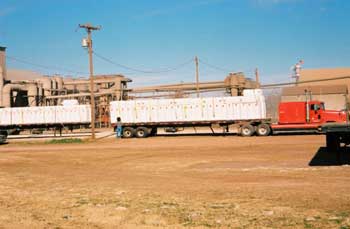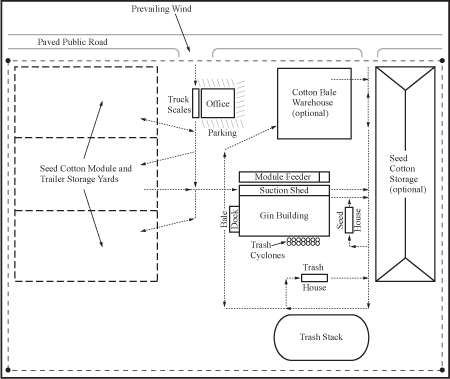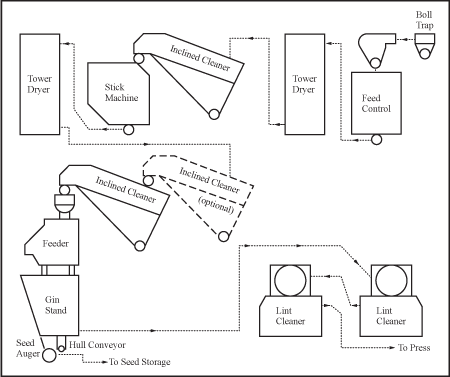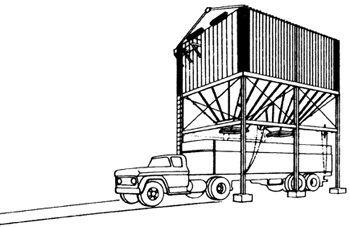Why Cotton Ginning Is Considered Agriculture
This article, which appeared in the April 16 issue of Cotton Gin & Oil Mill Press magazine, demonstrates that cotton ginning is correctly classified as an agricultural operation instead of general industry to avoid being subjected to inappropriate, burdensome, and costly general industry standards, which could adversely affect both the operation of a gin and cotton quality.
P.J. Wakelyn, D.W. Thompson, and B.M. Norman
National Cotton Council
Washington, DC and Memphis, TN
C.B. Nevius and D.S. Findley
Southeastern Cotton Ginners’ Association
Dawsonville, GA
Appeared in Cotton Gin & Oil Mill Press 106(8) 5-9, April 16, 2005
Introduction
Officially, cotton ginning always has been an agricultural operation. However, questions frequently are raised by state and federal regulatory agencies and standard-setting code organizations regarding the classification of cotton ginning as agriculture rather than as a general industry process. It is very important that cotton ginning is correctly classified as an agricultural operation instead of general industry to avoid being subjected to inappropriate, burdensome, and costly general industry standards, which could adversely affect the operation of a gin and cotton quality.
Some state Occupational Safety and Health Administrations (OSHAs) raised this issue most recently in 2001-02. Federal OSHA issued a standards interpretation to clarify that ginning is agriculture under OSHA standards (see below). More recently, the fire marshals in some states have wanted to apply general industry fire codes to cotton ginning because they incorrectly considered seed cotton the same as loose fiber for fire and building codes and have considered cotton as a highly combustible material for storage. In 2004, based on the extensive research conducted by and for the U.S. cotton industry (Wakelyn and Hughs, 2002) meaningful changes in the 2005 National Fire Protection Association (NFPA) Code Revisions have been accomplished (Wakelyn et al., 2005, 2004). The same course of action has been followed in 2005 for International Code Council (ICC) changes to the 2006 Code Revisions. These changes have been approved by their International Fire Code (IFC) committee.
This paper explains why cotton ginning is an agricultural operation.
The U.S. Government considers cotton ginning to be an agricultural operation.
Cotton is both a fiber (used for textiles) and food crop (used for human food and animal feed). Seed cotton is removed from the field by a harvester and put into modules or trailers and taken to the cotton gin to finish the harvesting process by separating the cotton fiber from the cottonseed.
Seed cotton [consisting of cotton fiber (lint) attached to cottonseed plus plant foreign matter] is a perishable raw agricultural product that has no value until the fiber and seed are separated by an agricultural process at the cotton gin -- which is an agricultural facility.
The U.S. government [U.S. Department of Agriculture (USDA), Department of Labor (DOL), OSHA, Internal Revenue Service (IRS), etc.] always has considered the ginning process an agricultural operation that essentially is an extension of the harvesting process. Cotton ginning is considered agriculture under the following government regulations:
- Federal OSHA and state OSHAs (including North Carolina) always have considered cotton ginning as agriculture and always have regulated cotton ginning under OSHA’s agricultural standards (29 CFR 1928).
“OSHA's long-standing position is that cotton ginning is an agricultural operation and not a general industry operation.”
“OSHA's agricultural standards (Title 29, Code of Federal Regulation, Part 1928)
specifically cover cotton gins in §1928.57, which deals with guarding of farm field equipment, farmstead equipment, and cotton gins.” [See OSHA document Standard Interpretations 08/06/2002 - Standards that apply to cotton gins. - In the harmonized U.S., Canadian and Mexican North American Industrial Classification System
(NAICS) code cotton ginning is “Support Activities for Crop Production” (115111). - Under the U.S. Standard Industrial Classification (SIC) code system cotton ginning is “Agricultural Services” (0724).
- Cotton ginning is listed under “agricultural labor” in
- the Internal Revenue Code [US Code, Section 3401 and 3121(g); and
- the Social Security Act [42 US Code, Section 410(3).
- The Fair Labor Standards Act considers gins as “agricultural employers.”
Cotton ginning is a continuation of the harvest to produce marketable raw agricultural commodities.
The cotton ginning process (Cotton Ginners Handbook, 1994) is analogous to other types of seasonal harvesting processes that produce raw agricultural products (Fig. 1 below: A sample gin yard arrangement). Typical cotton gins operate in mostly rural areas for one to two months per year. On rare occasions when cotton production exceeds expectations, the ginning season may last for four or more months. This is followed by a repair period when maintenance is performed in preparation for the next ginning season. Unless major renovations are scheduled during the off- season repair period, only skeleton crews are present. During this period, no seed cotton, cottonseed, cotton bales or other gin waste are kept or allowed inside the ginning facility unless a piece of ginning machinery is being tested. Normally, testing of repaired or new machinery is delayed until the start of the new ginning season.
 |
| Densely-packed bales loaded for transport from the gin. |
The products of the ginning process (Fig. 2 below: Cotton flow through the gin) are: 1) cotton bales and mote bales (Fig. 3 right: Densely-packed cotton bales loaded for transport from the gin), 2) cottonseed that is conveyed to a separate holding facility from the gin plant (Fig. 4 below: Cottonseed loaded for transport from the gin), and 3) gin by-products that also are conveyed away from the gin plant. At cotton gins, specially designed equipment combines and performs functions that are agricultural, not industrial, processes. Therefore, ginning is considered by OSHA, IRS, NAICS and SIC codes, etc. to be agriculture and a continuation of the harvest (see list above). These harvesting functions are similar to those performed by grain harvesting/thrashing machines, i.e., combines, hay balers and other harvesting equipment exclusively designed for agricultural purposes.
The module is the primary unit of temporary seed cotton storage after seed cotton is removed from the field by a harvester and prior to ginning. As seed cotton is moved from the field to the gin, the harvesting process continues – raw agricultural products (cotton lint/fiber, cottonseed and motes) are produced by the ginning process that are transported away from the gin to be used in industrial operations. To facilitate the continuation of the harvesting process, module feeders meter seed cotton into the gin at a uniform rate in a uniform stream. Both cotton field harvesters and gin plants rely on pneumatic fans to move cotton through their systems. As the module is broken apart and fed into the ginning system, centrifugal force separates green bolls as well as potentially hazardous materials such as stones and metallic objects from the seed cotton. Strategically placed rock traps and magnets in the air ducts and machinery remove rocks and capture ferrous objects before they can get into the ginning stream.
The next process utilizes mechanical devices designed to remove cotton burrs, sticks, stems, sand and dirt, and similar trash (“cotton gin by-products”). This process is generally referred to as drying and pre-cleaning. One of the machines used in the pre-cleaning process is referred to as a “stick machine” and/or a “burr extractor.” Many cotton growers recognize the benefits derived from performing burr and stick extraction operations in the field. Consequently many new “stripper” type cotton harvesters now have on-board burr machines – enabling this function to be performed in the field.
Following pre-cleaning comes the ginning and lint cleaning processes. At the “gin feeder,” the seed cotton is separated so that single locks of seed cotton are fed into and through the “gin stand.” The gin stand takes seed cotton and separates it into lint (cotton fiber, a raw agricultural feedstock) and cottonseed (a raw agricultural commodity with several uses). The lint cleaner provides the first opportunity for combing and precision cleaning of the cotton fiber and separates the foreign material into a separate process stream of by-products called motes. After ginning and lint cleaning, the combed lint is pneumatically conveyed to a “condenser,” which forms the cotton lint into a “batt” and then meters and feeds the stream of batted lint down a “lint slide” into the bale press. The function of the bale press is to produce uniform, compact, densely- packed bales of cotton lint that go to warehouses for storage or directly to textile mills for processing into apparel, home furnishings and other textiles. The bale of lint is the first form of cotton lint that has any market value to a cotton producer and subsequently to other handlers of the crop. Prior to the ginning and subsequent baling of the lint cotton, there is no marketable commodity that exists. Following ginning, lint cleaning and baling there exists marketable commodities of cotton lint, cottonseed, mote and cotton by-products (foreign material). This fact is key to understanding why ginning is considered an extension of the harvest.
The cottonseed is continually conveyed away from the gin stand by screw type conveyors and removed from the gin building by pneumatic conveying systems. Once outside the gin building, the cottonseed either goes into an overhead storage unit equipped with hopper bottoms to facilitate the loading of trailers or large buildings called seed houses. The seed is sent by truck or rail either to be fed as whole seed to dairy cattle or to a cottonseed oil mill where it is processed to produce cottonseed oil (used for human consumption), cottonseed meal and hulls (used for animal feed), and linters (used for paper or as chemical cellulose raw material to produce other products) (Wakelyn and Wan, 2001).
Burrs, sticks and other gin by-products are conveyed away from gin buildings and stored either in hopper bottomed storage houses or in large piles until they can be removed. Burrs and other gin by-products may be composted, fed as roughage to cattle or hauled and dumped back on farms or pasture land. Gin motes are considered a by-product that is typically separated and sold for various uses such as batting/felt or in waste spinning to make low grade fabrics or mops.
It should be noted that virtually all processing equipment and pneumatic conveyors are enclosed by sheet metal which contains the cotton as it moves through the ginning process. This is the case from the time the seed cotton enters the gin at the module feeder until the lint exits the gin following compression at the bale press and the cottonseed and gin waste are conveyed away from the gin. These enclosed systems are fed by the pneumatic conveyor systems, which contain numerous valves that direct the flow of cotton during ginning. The ginning system is designed so that the cotton remains virtually isolated from the surrounding environment as it moves through the cotton gin. Should a fire occur during processing, procedures are in place to ensure that loss of the valuable lint and damage to ginning machinery is kept to a minimum. The cotton can (1) be isolated and starved for oxygen inside the machinery, (2) be shunted into an open area where smoldering cotton can be isolated and wet down with low pressure water to put out the fire, or (3) be baled into densely-packed bales at the bale press then quarantined to ensure that no fire can spread to other bales.
Cotton gin buildings should be considered agricultural buildings in the fire code requirements.
Cotton Warehouses have specific fire code requirements that are found under warehouses.
Textile mills have specific general industry fire code requirements.
Cottonseed oil mills, where cottonseed oil, meal, hulls and linters are produced from the seed have specific fire code requirements.
Seed cotton, which is a perishable raw agricultural commodity, is not a combustible fiber or a hazardous material. The fire code requirements for combustible fibers should not be applied to cotton ginning of seed cotton. Densely-packed cotton bales are not a hazardous material – ICC and NFPA have approved, in principle, amendments to their fire and building codes recognizing this.
The fire code requirements for cotton ginning facilities should be under agricultural buildings. Fire code requirements for industrial buildings should not be applied to cotton ginning of seed cotton because once seed cotton enters the gin it is contained within piping or machinery. Water from automatic fire sprinklers would not be able to reach any ignited cotton. In the event of an in process fire, procedures set forth in The Ginners Handbook (1994), call for the flow of seed cotton into the gin plant to be stopped. If fire exists in the process stream ahead of the conveyor distributor that feeds the gin stands, fire doors in the distributor and in the gin stands should be opened, which allow the seed cotton to flow onto the floor outside of the process machinery. There, low pressure water can be best applied manually to any smoldering seed cotton and then the material can be removed from the facility. Cotton lint in the process piping and machinery behind the gin stands should be allowed to flow to the press. It is then pressed out into a densely packed bale and quarantined for a week or more. The same process applies for cotton lint if the fire originates at the gin stand or downstream from that point. Established procedures call for the two bales before the fire and the two bales after the fire to be quarantined. Insurers of cotton gins do not want automatic fire sprinklers in cotton gins because gins use 480-volt electrical systems and many micro processor and other sensitive controls.
Once seed cotton and lint have been contained per the procedure above, the gin process should be stopped and all machinery inspected to make certain all smoldering material (including trash and seed streams) has been extinguished, contained and removed. A thorough inspection is necessary so that the fire’s origins is/are identified and corrected/removed to prevent a reoccurrence. The experience of insurers has shown that excessive use of high pressure water in and around the process machinery does little to control fire and actually causes more damage than the fire itself. Low pressure, water-filled extinguishers and garden water hoses are the recommended ways to apply water to a seed cotton, cotton lint, cottonseed or by-product fire when inside a ginning facility. High pressure applications inside the gin facility usually do more to spread the fire than to contain it, if origins are in the process stream. The authors are not aware of a fire-related fatality in the U.S. ginning industry in the last ten years or a case of a cotton gin burning for any significant loss while operating.
Summary/Conclusion
The U.S. government always has considered cotton ginning an agricultural operation that is essentially part of the harvesting process (USDA, DOL, OSHA, IRS, etc.). Seed cotton is considered a perishable raw agricultural product by USDA that has no value until the fiber and seed are separated by an agricultural process at the ginning facility, which should be considered an agriculture building.
 |
| Fig. 1 A sample gin yard arrangement. |
 |
| Fig. 2 Cotton flow through the gin. |
 |
| Fig. 4 Cottonseed loaded for transport from the gin. |
Cotton Ginners Handbook. 1994. U.S. Department of Agriculture, Agriculture Research Service, Agricultural Handbook Number 503
P.J. Wakelyn and S.E. Hughs. 2002. Evaluation of the Flammability of Cotton Bales. Fire and Materials 26, 183-189.
P.J. Wakelyn, D.W. Thompson, and B. Nevius. 2004. U.S. Codes Applicable to Baled Cotton Storage – Revision of Codes and Standards: International Code Council and National Fire Protection Association. Proc. 2004 Beltwide Cotton Conferences. National Cotton Council, Memphis, TN. 2004. pp. 1017-1020.
P.J. Wakelyn, D.W. Thompson, and C.B. Nevius. 2005. Actions to Amend U.S. Fire and Building Codes Applicable to Baled Cotton Storage. Proc. 2005 Beltwide Cotton Conferences. National Cotton Council, Memphis, TN. 2005. pp.
P.J. Wakelyn and P.J. Wan. 2001. An Overview of Oil Extraction and Refining. Oil Mill Gaz. 106(8), 14-22.

